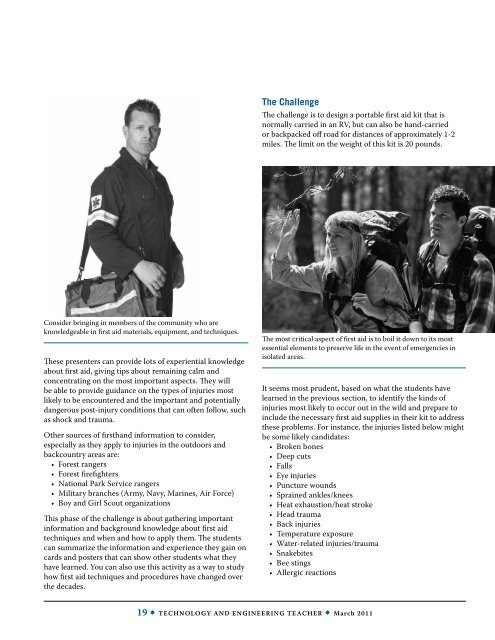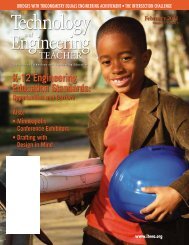March - Vol 70, No 6 - International Technology and Engineering ...
March - Vol 70, No 6 - International Technology and Engineering ...
March - Vol 70, No 6 - International Technology and Engineering ...
You also want an ePaper? Increase the reach of your titles
YUMPU automatically turns print PDFs into web optimized ePapers that Google loves.
The Challenge<br />
The challenge is to design a portable first aid kit that is<br />
normally carried in an RV, but can also be h<strong>and</strong>-carried<br />
or backpacked off road for distances of approximately 1-2<br />
miles. The limit on the weight of this kit is 20 pounds.<br />
Consider bringing in members of the community who are<br />
knowledgeable in first aid materials, equipment, <strong>and</strong> techniques.<br />
These presenters can provide lots of experiential knowledge<br />
about first aid, giving tips about remaining calm <strong>and</strong><br />
concentrating on the most important aspects. They will<br />
be able to provide guidance on the types of injuries most<br />
likely to be encountered <strong>and</strong> the important <strong>and</strong> potentially<br />
dangerous post-injury conditions that can often follow, such<br />
as shock <strong>and</strong> trauma.<br />
Other sources of firsth<strong>and</strong> information to consider,<br />
especially as they apply to injuries in the outdoors <strong>and</strong><br />
backcountry areas are:<br />
• Forest rangers<br />
• Forest firefighters<br />
• National Park Service rangers<br />
• Military branches (Army, Navy, Marines, Air Force)<br />
• Boy <strong>and</strong> Girl Scout organizations<br />
This phase of the challenge is about gathering important<br />
information <strong>and</strong> background knowledge about first aid<br />
techniques <strong>and</strong> when <strong>and</strong> how to apply them. The students<br />
can summarize the information <strong>and</strong> experience they gain on<br />
cards <strong>and</strong> posters that can show other students what they<br />
have learned. You can also use this activity as a way to study<br />
how first aid techniques <strong>and</strong> procedures have changed over<br />
the decades.<br />
The most critical aspect of first aid is to boil it down to its most<br />
essential elements to preserve life in the event of emergencies in<br />
isolated areas.<br />
It seems most prudent, based on what the students have<br />
learned in the previous section, to identify the kinds of<br />
injuries most likely to occur out in the wild <strong>and</strong> prepare to<br />
include the necessary first aid supplies in their kit to address<br />
these problems. For instance, the injuries listed below might<br />
be some likely c<strong>and</strong>idates:<br />
• Broken bones<br />
• Deep cuts<br />
• Falls<br />
• Eye injuries<br />
• Puncture wounds<br />
• Sprained ankles/knees<br />
• Heat exhaustion/heat stroke<br />
• Head trauma<br />
• Back injuries<br />
• Temperature exposure<br />
• Water-related injuries/trauma<br />
• Snakebites<br />
• Bee stings<br />
• Allergic reactions<br />
19 • <strong>Technology</strong> <strong>and</strong> <strong>Engineering</strong> Teacher • <strong>March</strong> 2011
















